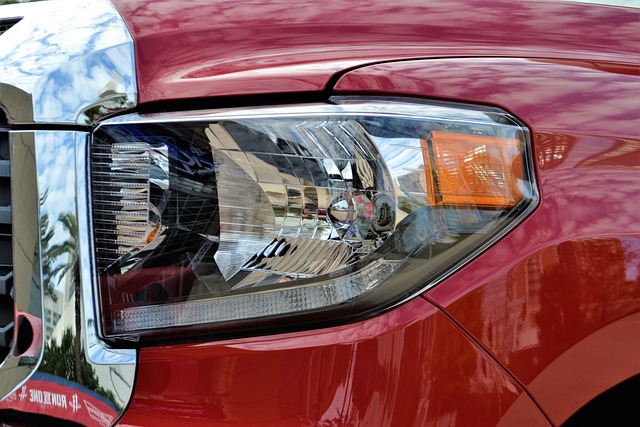Brownsville fleet Truck repair manual recommends bumper guards for protecting trucks from collisions and accidental impacts. Choosing the right guard involves considering material, design, compatibility, alignment with maintenance goals, driving conditions, and budget. Proper installation and regular maintenance, as outlined in the manual, extend the lifespan of critical truck parts, reduce repair costs, and minimize downtime. Investing in bumper guards offers long-term benefits, including increased vehicle longevity, better driver safety, and improved fuel efficiency, leading to cost-effective fleet management.
Bumper guards are essential accessories for truck repair and maintenance. They provide crucial protection against damage during parking or minor collisions, reducing costly repairs. This article explores the role and benefits of bumper guards, delving into different types, their installation, and the significant impact on truck fleets, as illustrated by a Brownsville fleet case study. Learn about material choices, design considerations, and how to ensure longevity while evaluating cost-effectiveness and return on investment.
- Understanding Bumper Guards: Their Role and Benefits in Truck Repair
- Types of Bumper Guards: Material, Design, and Compatibility Considerations
- Brownsville Fleet Case Study: Implementing Bumper Guards for Optimal Protection
- Step-by-Step Guide to Installing Bumper Guards on Your Truck
- Maintenance and Longevity: Ensuring Your Bumper Guards Stay Effective
- Cost-Effectiveness and Return on Investment: Measuring the Value of Bumper Guards
Understanding Bumper Guards: Their Role and Benefits in Truck Repair

Bumper guards play a pivotal role in truck repair, offering both functional and financial benefits for Brownsville fleet owners. These robust barriers are designed to protect the front and rear ends of trucks from damage caused by collisions, obstacles, or accidental impacts during everyday driving and loading/unloading operations. By absorbing and deflecting impact forces, bumper guards significantly reduce the risk of costly repairs and downtime.
In a Brownsville fleet management manual, prioritizing the installation of high-quality bumper guards is recommended as a proactive measure. They not only safeguard the truck’s structure but also extend the lifespan of other critical components like suspension systems, axles, and wheels. Moreover, in the event of an accident, properly fitted bumper guards can minimize repair expenses, ensuring that the truck remains operational with minimal disruptions to daily schedules.
Types of Bumper Guards: Material, Design, and Compatibility Considerations

When selecting bumper guards for your Brownsville fleet Truck repair manual, several factors come into play. Material is a primary consideration; options range from durable metal to impact-resistant plastic, each offering unique advantages and compatibility with different vehicle models. Design also plays a crucial role; guard designs can vary based on the level of protection needed, whether it’s for mild road conditions or harsher environments.
Compatibility is another essential aspect. Bumper guards must fit seamlessly onto your fleet’s existing bumpers without compromising the vehicle’s aesthetics or structural integrity. This involves careful measurement and consideration of your truck models’ specific dimensions and design elements. Your choice should align with your maintenance goals, driving conditions, and budget, ensuring optimal protection for your Brownsville fleet vehicles.
Brownsville Fleet Case Study: Implementing Bumper Guards for Optimal Protection

The Brownsville Fleet Truck repair manual highlights an effective implementation of bumper guards as a game-changer in fleet maintenance. This case study showcases how these protective barriers can significantly reduce damage and costs associated with rear-end collisions, common in heavy-duty vehicles. By strategically placing bumper guards, the Brownsville Fleet minimized the impact of accidents, ensuring faster repairs and maintaining their vehicle’s overall integrity.
The manual emphasizes the importance of choosing the right type of bumper guard for each truck model, considering factors like vehicle weight, speed, and typical operating conditions. This tailored approach ensures optimal protection without compromising on maneuverability or fuel efficiency. The success of the Brownsville Fleet’s initiative underscores the value of proactive measures in fleet management, demonstrating that preventing damage is more cost-effective than repairs after an incident.
Step-by-Step Guide to Installing Bumper Guards on Your Truck

To install bumper guards on your truck, follow this step-by-step guide tailored for Brownsville fleet owners using a Truck repair manual.
1. Measure and Cut: Begin by measuring the length of your truck’s bumper. Cut the guard to size using a sharp pair of shears or a saw, ensuring a precise fit.
2. Prepare the Surface: Clean the bumper surface thoroughly, removing any dirt, grease, or debris. This step is crucial for a secure bond between the bumper guard and your vehicle. Use a degreaser if necessary and ensure the area is dry before proceeding.
3. Attach the Guard: Refer to your truck repair manual for specific mounting points. Securely attach the bumper guard using screws or brackets recommended by the manufacturer. Ensure all fasteners are tightly fastened, following the manual’s guidelines.
4. Test and Adjust: Once installed, test the stability of the guard. Make any necessary adjustments to ensure it is securely attached and aligned properly.
Maintenance and Longevity: Ensuring Your Bumper Guards Stay Effective

Proper maintenance is key to keeping your bumper guards effective and prolonging their lifespan. Brownsville fleet Truck repair manuals offer detailed guidance on regular upkeep, including inspecting for damage, cleaning to prevent debris buildup, and lubricating moving parts (if applicable). By adhering to these practices, you can ensure your bumper guards remain in top condition, providing maximum protection for years to come.
Additionally, understanding the specific requirements of your bumper guard model is essential. Some may need more frequent attention than others, depending on factors like material and environmental exposure. Staying informed about best practices tailored to your fleet’s unique needs will contribute to a robust maintenance routine, ultimately enhancing the overall efficiency and safety of your vehicles in Brownsville.
Cost-Effectiveness and Return on Investment: Measuring the Value of Bumper Guards

Investing in bumper guards for your Brownsville fleet Truck repair manual can seem like a simple cost item, but its value extends far beyond initial expenditure. While the upfront cost may be considered an additional expense, the long-term benefits make it a smart and cost-effective decision. Bumper guards protect your vehicles from everyday wear and tear, preventing damage that could lead to costly repairs or replacements. By safeguarding your fleet’s assets, you’re ensuring smoother operations and reducing unexpected maintenance bills.
Measuring the return on investment (ROI) is straightforward. With regular use, bumper guards can significantly extend the lifespan of your trucks, minimizing downtime and keeping your fleet in top condition. This translates to improved fuel efficiency, as well as better safety for drivers due to enhanced vehicle stability. In a competitive market like Brownsville, where efficient operations are key, prioritizing cost-effectiveness with bumper guards can give you a competitive edge while fostering a culture of responsible fleet management.
Bumper guards have proven to be a game-changer in truck repair, offering significant protection to one of the vehicle’s most vulnerable areas. As demonstrated by the Brownsville fleet case study, their implementation can lead to reduced damage and maintenance costs. By following the step-by-step installation guide and ensuring proper maintenance, fleet owners can maximize the benefits of bumper guards. In terms of return on investment, the cost-effectiveness is evident, making them a wise choice for any truck repair manual.



